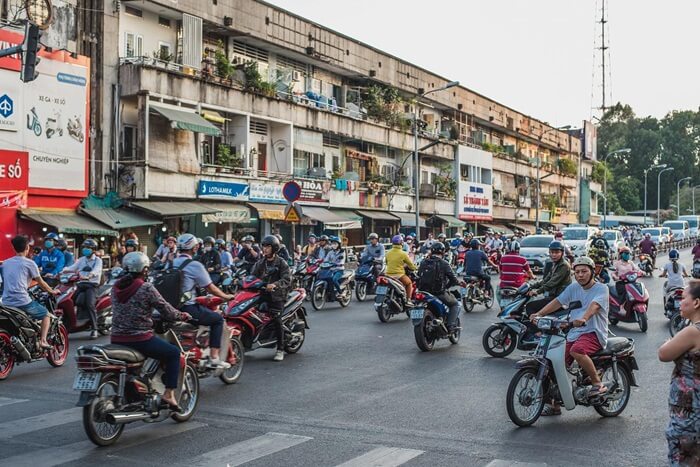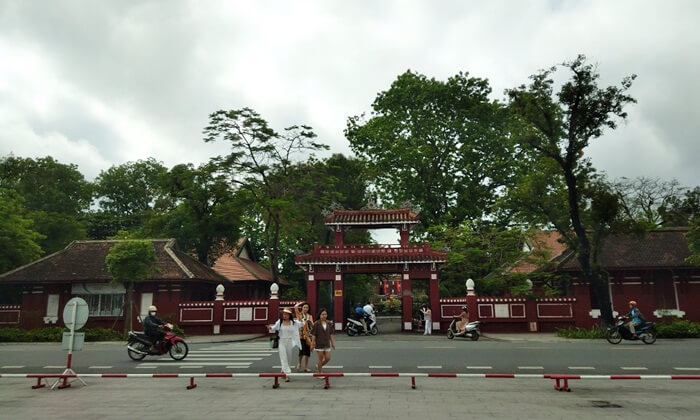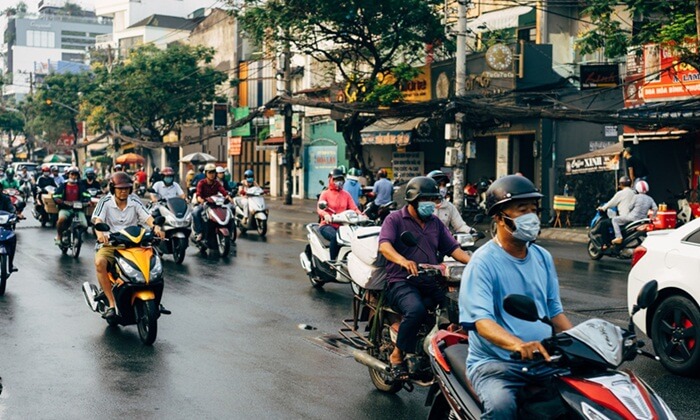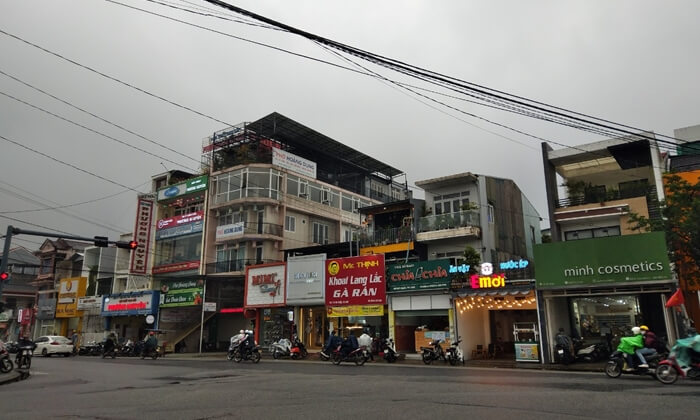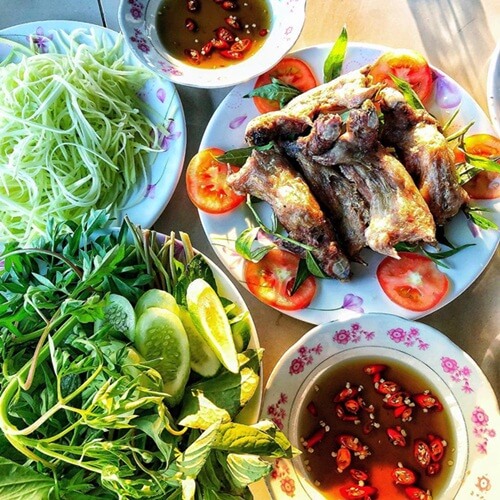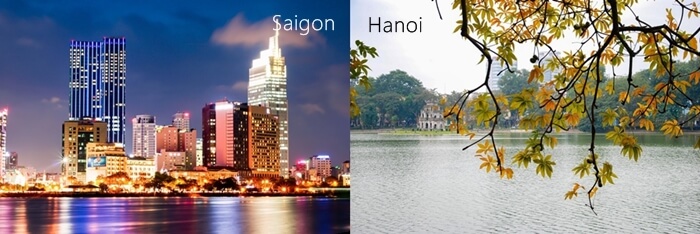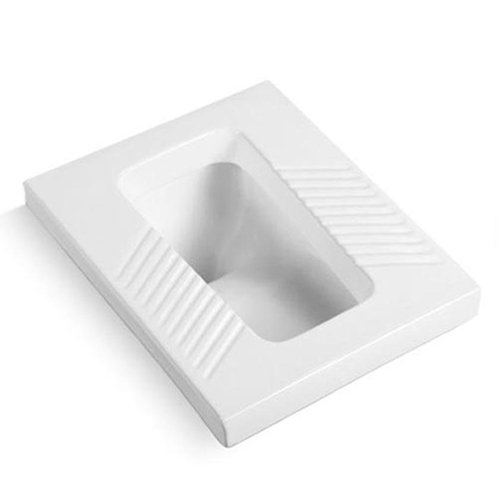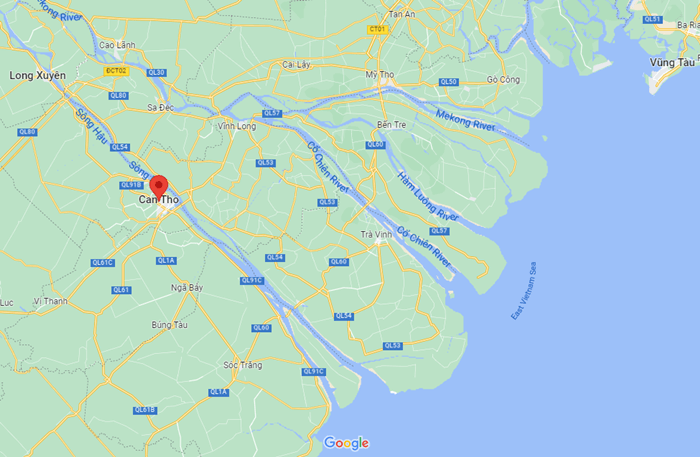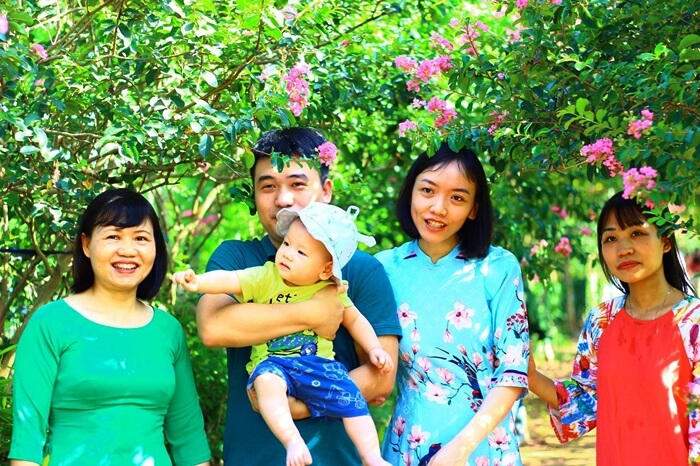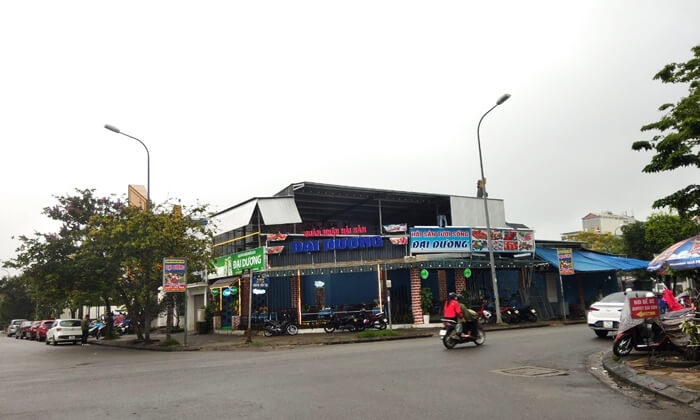There are many interesting facts in Vietnam that surprise not only foreign tourists but also Vietnamese people.
In this article, Vietnamdrive has selected the top exciting and fun facts to introduce to you, maybe they will help you more or less when you travel to this beautiful country.
Fact 1: Traffic is as confusing as a spider web.
Traffic is one of the top concerns of most tourists when visiting Vietnam. It is because when you set foot in this beautiful country, you will become a factor in the vibrant and quirky traffic rhythm here.
During rush hours, Vietnam’s traffic begins to become bustling. In particular, intersections and roundabout areas are considered the convergence point for all “oddities” of traffic in this country.
Standing right in front of any roundabout, specifically looking at it from above, you will see the traffic flow is complicated. It looks like a strange machine pre-programmed with IA technology for smooth movement. But the more you look, the less you will be able to understand what the main rules are applied by traffic participants right on the roads. It’s like a hypnotic circle that makes you dizzy.
Many people think that perhaps there is some hidden convention or a “telepathic” connection between people participating in traffic on the road. Thus, they can clearly understand each other right away while they move. In fact, everyone is conscious of obeying the traffic rules and moving according to the principle of yield.
That principle of yielding has become a habit for every Vietnamese person when traveling on the streets. And it is a vital factor that helps Vietnamese traffic look confusing but still smooth.
As a first-time tourist to Vietnam, we do not encourage you to drive your own car, motorbike, or even bicycle on the streets, especially in big cities like Hanoi and Ho Chi Minh. To ensure your safety and a perfect trip, it is better to contact a travel company to arrange reasonable transportation. Vietnamdrive is always with you to help you do that.
Fact 2: Crossing the street is a “breathtaking” experience.
Crossing the street for the locals seems very easy, but for foreigners, it is a “breathtaking” challenge. During their first visit to Vietnam, many international tourists spend a lot of time testing their courage at pedestrian crossings.
As soon as they try to put one foot on the road, they have to immediately step back onto the sidewalk. Many tourists humorously say that when you cross the streets in Vietnam, you are going on a free adventure tour or maybe participating in the most unique Halloween festival on the planet.
Although there are lines for pedestrians to cross the streets, and Vietnamese law also stipulates that pedestrians have priority, you will not see any vehicle stopping to give way to walkers crossing the roads.
Pedestrians keep walking while vehicles move according to the “roundabout” principle. This means that the drivers control their means to pass in front or behind the walkers depending on the distance and speed of the crossers as well as other vehicles. So, when you cross the streets, calmly walk, don’t run, and never turn back while you’re in the middle of this “unique adventure”.
In places with traffic lights, crossing the street seems easier. However, you are not subjective because, at many intersections, vehicles are still allowed to turn right when the red light signals.
A good suggestion for you when crossing the streets in Vietnam is to follow the locals. You can also seek their support if you cannot cross the road alone. Of course, remember that the elders and children cannot support you in solving this problem.
Fact 3: The country has the most motorbikes in the world.
According to the Vietnam Motorcycle Manufacturers Association, every day, more than 8,000 motorbikes are sold across the country, equivalent to nearly 6 new motorbikes purchased every minute. (source: tuoitre.vn)
The number of motorbikes in Vietnam may be extremely large, and they have become the most popular means of personal transportation. This makes Vietnam become one of the countries with the highest proportion of motorbike users in the world.
In big cities like Hanoi, Ho Chi Minh, or Hai Phong, you will be overwhelmed with long lines of motorbikes on the streets. Motorcycles circulate everywhere, on all large and small roads. During rush hours, whether on the car lane or the sidewalk, as long as there is a space, a motorcycle will immediately fill it as a matter of course.
Like most major cities in the world, Ho Chi Minh City gets traffic jams that often last for hours and often occur. The main difference lies in the number of motorbikes that cover the entire congested road.
If you are unlucky in that line of vehicles in jams, it will be an unforgettable experience when everywhere is filled with the smell of dust, engine sounds, horns, and sometimes even angry sounds that are difficult to know.
Look at the traffic jam on the street from the sky, cars that fortuitously fall into the circle of motorbikes will still be like unmovable prey. Hundreds of motorbikes follow each other inching forward, behind, left, and right as if wanting to “swallow” each car lying helplessly on the road.
It is because of the usefulness and convenience when traveling on narrow roads, motorbikes have become suitable and popular in Vietnam. Then, it creates the unique traffic culture of this beautiful country.
Some adventurous travelers visiting Vietnam choose motorbikes as a means of transportation as part of their exciting journey of discovery. However, this is an experience that we do not encourage you to try because the level of danger is real.
Fact 4: The spirit of entrepreneurship and business is widespread.
Thousands of large and small shops, including coffee shops, milk tea shops, eateries, and snack shops covering the streets, are proof of the entrepreneurial spirit of Vietnamese people.
In addition to the crucial business and production sectors controlled by the state to balance life and society, the small projects of the locals are an indispensable factor contributing to the appearance of the economy. A large number of people in Vietnam choose to do freelance business to improve their desire to be self-employed in terms of time, finances, and lifestyle.
All over Vietnam, from rural to urban areas, especially in crowded streets and near supermarkets and large restaurants, are a series of small shops. They exist and thrive thanks to convenience and competitive prices.
A powerful entrepreneurial spirit also plays a vital role in forming a flavorful street food scene in Vietnam. This feature enriches Vietnamese cuisine, which becomes a good plus point in attracting foreign tourists.
Fact 5: In many places, mouse and snake meat is still a specialty dish.
Have you ever imagined having a plate of mouse meat on the dining table or preparing this typical dish in your kitchen?
In Vietnam, for many people, mouse meat is a delicious and irresistible specialty. They can process mice into countless tasty dishes: steamed, boiled, grilled, roasted, sauteed, stir-fried with lemongrass and chili, roasted, etc. It can be used as a daily dish, snack food for men to enjoy with beer or a unique one to treat guests.
With the characteristics of an agricultural country specializing in wet rice cultivation, field mice are a familiar object to Vietnamese farmers. The mice have small bodies and live in wet rice fields, and their major food is rice and young seedlings. Therefore, rice-field mouse meat is clean, tasty, and rich in nutrients.
The habit of eating field mice has existed for a long time in rural areas of Vietnam when farmers’ lives were still struggling and lacking food sources. During the flooding season, mice from the rice fields lose their shelters and find their way to higher areas. That’s when people come together to catch rice for food. This habit has lasted for many generations to this day: mouse meat is still a Vietnamese specialty, which is a part of the culture of wet rice agriculture.
Besides mice, snakes are also food for a large group of Vietnamese people. Due to the unique food source, snake meat is expensive compared to other common dishes. In many areas, people also build snake farms to provide meat for restaurants specializing in serving this typical food.
According to Vietnamese Oriental Medicine, snake meat has a sweet and salty taste, a fishy smell, and warm properties. It also has the effect of repelling leprosy, reducing fever, and eliminating dampness. With the high nutritional content, many people use snakes as a rich nutrition source to nourish the body.
In addition to processing snakes into common dishes, such as porridge, stir-frying with lemongrass and chili, or making sausage, snakes are also a valuable ingredient in favorite snake wine bottles for many Vietnamese men.
Currently, the number of people in Vietnam who eat mouse and snake meat is decreasing, so the number of restaurants selling these specialties is not much, so it is hard to find them. Usually, only locals know where it is.
In addition to strange dishes like mice and snakes, you will also see many people eating balut eggs (called Trung Lon in Vietnamese), coconut worms, duck blood pudding, and pig blood pudding. But Vietnamdrive advises you to think carefully before trying any strange dishes in Vietnam.
Fact 6: Hanoi is the capital, but the economy in Ho Chi Minh City has developed strongly.
Many tourists mistakenly believe that Ho Chi Minh City is the capital of Vietnam, but in fact, Hanoi is the capital of this beloved country. These are the two largest cities, located at two ends of the country: Hanoi in the north and Ho Chi Minh in the south.
If Hanoi is the leading administrative center, then Ho Chi Minh City is the economic engine of the country.
The economy in HCM is dynamic, covering a full range of key economic sectors such as finance, trade, services, tourism, transportation, logistics, high technology, software technology, and industrial manufacturing. The powerful development of the economy, culture, and modern urban life has made Ho Chi Minh City become a highlighted landmark in Vietnam.
Both Hanoi and Ho Chi Minh are economic locomotives and important cultural, educational, and medical centers of the country. However, each place stands out with its own unique culture and lifestyle. The cultural imprint of each place is clearly shown through accent, way of speaking, cuisine, architecture as well as house layout, or communication culture. If possible, don’t miss these two cities when you travel to Vietnam. And, pay attention to the narrow houses, you will see interesting things.
Fact 7: Some places still use flat toilets.
A flat toilet requires the users to do the Asian squat skillfully. Not being able to squat or not squatting long enough will definitely cause you to have stinky trouble with this toilet style.
Flat toilets in Vietnam are still quite popular, especially in rural areas or public restrooms, because it is not a problem for the locals and seems cleaner in a few situations. However, for international tourists, these toilets have become a concern for them.
If you are traveling in Vietnam, it is better to learn how to use this unique type of toilet in advance because it can appear at some tourist attractions in rural areas, public stops, or gas stations on a long journey. Practice the Asian squat, which can help you use the toilet more easily and confidently in this country in some cases.
We encourage you to “release all the excess inside your body” at the hotel before getting on the bus to go sightseeing. This is because most toilets at the rest stops on routes are of poor quality.
Although drivers try to choose locations that specialize in serving tourists so that they can conveniently use the “happy house”. However, it is still unavoidable that the toilet smells and only has a squat toilet. So, don’t be disappointed and dissatisfied with the drivers when they can’t find a place with better restrooms than you expected.
Fact 8: There is a land where “nine dragons” reside.
Belonging to the southern region of Vietnam, the Mekong Delta is called Cuu Long, meaning nine dragons. It’s because there are nine large winding rivers carrying alluvium to the entire delta before flowing into the sea, like the shape of nine rising dragons. Therefore, local people call this region the land of Cuu Long.
This area has a dense river network: 1 km2 is estimated to have up to 0.61 km of rivers and canals. Along with two large rivers, the Tien River and Hau River, the tributaries in the Mekong Delta have a total length of nearly 14,900km.
When you visit this land, you will see a unique lifestyle on water and transporting goods mainly by boat. The local life has created a strange beauty that attracts plenty of tourists.
You can explore the river life of the people in the “nine dragon” land with one-day tours from Ho Chi Minh City to Ben Tre or My Tho. With a longer duration, Can Tho city may attract you with the beauty of the Cai Rang floating market every early morning.
>> You may want to check the beautiful rivers in Vietnam.
Fact 9: Your mind is confused about how to call the correct hierarchy.
Addressing people correctly according to hierarchy and relationship is always a “brain-damaging” problem for not only foreigners but also Vietnamese people, especially young people.
Before making a decision about a certain way of addressing, you must determine the relationship between yourself and the other person. If you are a friend of the same age or someone younger than you, just calling them by their first name is enough.
On the contrary, if the other speakers do not belong to two groups of friends or younger people, it starts to become more confusing. Vietnamese people call each other according to each person’s correct hierarchy, but that hierarchy is only established in the relationship with each specific communication object. However, this person’s relationship with different people is not the same, so it becomes a “brain hack” point in Vietnamese communication culture.
For example, with the same man named “Nam,” but in each different relationship, this person’s title will not be the same. It could be Cháu (nephew), Anh (brother), or Chú (uncle). And so, you will encounter the phenomenon that sometimes this person is called Anh Nam (older brother Nam), and other times Chú Nam (uncle Nam).
This hierarchy is most problematic in kinship relationships, where, at times, a much older person must call a very young person Anh (an older brother), Chú (uncle), or Ông (grandpa).
In daily social communication, the hierarchy of address will be simpler:
- For younger people, just call “Em” – you’re Anh/Chị (older Brother/Sister);
- People of the same age call each other Bạn (Friends);
- A little older is called Anh/Chị (older Brother/Sister) – you’re “Em”;
- 18-20 years old can call Chú/Dì (Uncle/Aunt) – you’re Cháu (Nephew);
- 25 years old or older can be called Bác (Uncle) – you’re Cháu (Nephew);
- For elderly people over 70, call them Ông/Bà (grandpa/grandma) and you Cháu (Grandchild).
These rules of calling hierarchy seem quite complicated. If you visit a Vietnamese family, it’s best to ask your friend how to address you appropriately.
If you say the wrong hierarchy by chance, it’s okay, just say sorry and ask again for the correct way to address someone. Many people are often happy with the inappropriate call of addressing them when they first meet.
Fact 10: Beer shops are everywhere.
A small country with nearly 98 million people, but it is a place with a large amount of beer consumed. Estimatedly, Vietnamese people drank 4.4 billion liters of beer in 2020. (source PLO information)
High consumption is the basis for many beer brands in Vietnam that race to develop and promote throughout the country. Beer prices in this country are cheap, and with the acumen of the manufacturers, this special drink is available everywhere. Therefore, coming to Vietnam, whether in the countryside or the city, from small alleys to big streets, you can easily see beer shops. To wit, Vietnam is a vast beer garden.
Almost every major city in Vietnam has its own beer brand with local characteristics, such as Huda in Hue, Hanoi beer, 333 in Saigon, and Laru in Da Nang.
Trying a few beers can be an exciting experience for your trip to this “100% drunk” country.
If you are a fan of beer, don’t miss the streets known as beer streets, such as Ta Hien Beer Street in Hanoi, Bui Vien Walking Street in Ho Chi Minh, and Vo Thi Sau Walking Street in Hue. And, there are hundreds of other restaurants ready to serve you cool beers.
Those are typical facts in Vietnam that Vietnamdrive would like to introduce to you. This S-shaped land also has many interesting things waiting for you.
Let’s explore Vietnam, experience its uniqueness, and find more exciting features from the cultural difference!
